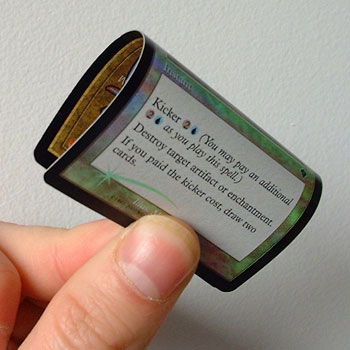3.4 Testing foils
- In 1999 Wizards of the Coast introduced premium foil chase cards into the Magic community starting in packs of Urza's Legacy. To date I have seen only a few fake foils. They are not very common because they require more skill to produce. Testing to see if a foil card is fake can't be done the same way as a regular card. Of course the best thing to do is to compare it with a copy you know is real.

| Foil cards may not pass the bend test. If you do bend your foils, do it
foil side out! This makes a big difference. The foil layer on a card is more likely to crease if you bend it inward.
Also, foils don't like to be bent more than once or twice. If at all possible, I say avoid bending your foils.
Since foil cards are thicker than regular cards, and because there is a thin layer of foil on the card, they are more difficult or impossible to see through even with a very strong halogen lamp, so the light test isn't really a good test here. More importantly the water test and microwave test will ruin a foil card completely so don't do them! Water can be used with great care on the inner surface of a card, but never on the edges! The slightest drop of water on the edge of a foil card will almost instantly wrinkle it. |
| Microwaves and metal of any kind (including foil cards) is a very bad idea. It will completely ruin the card, not to mention smell bad and possibly harm the microwave. I know you're all dying to know what DOES happen to a foil in the microwave, but don't want to ruin your cards, so I've done it for you. What happens is sparks dance across the surface, there's a big crackling sound, and the foil cracks, bubbles and peels off the card. Click here to see what happened to my foil Simian Grunts after just 5 seconds. |

|